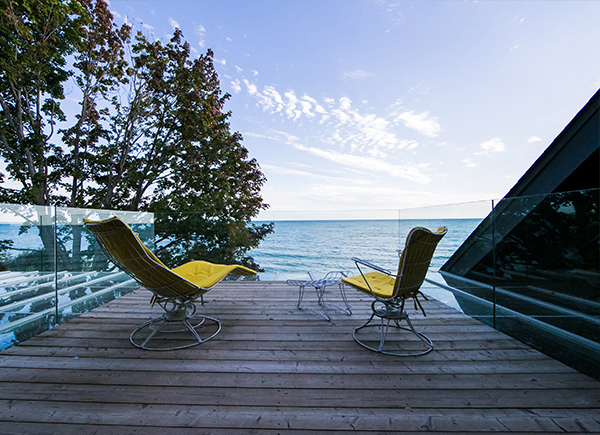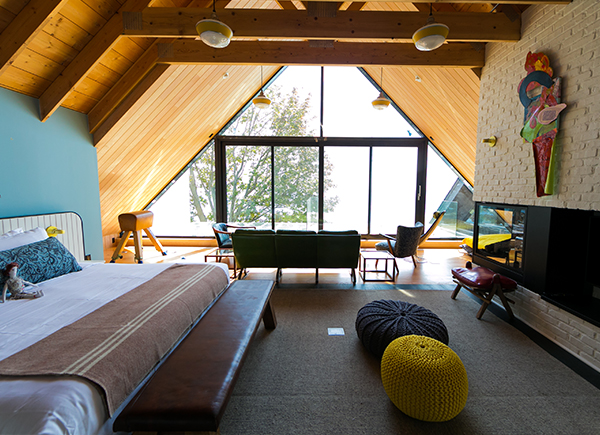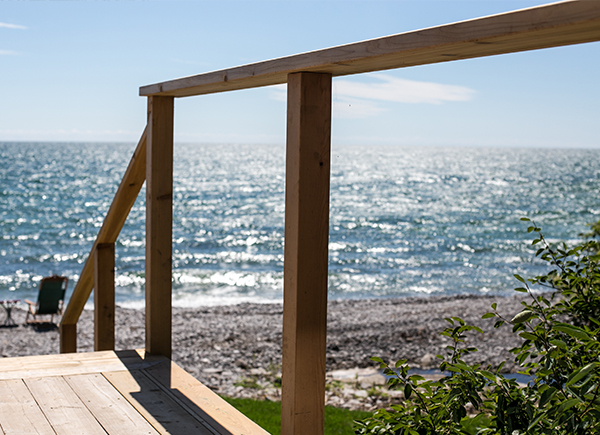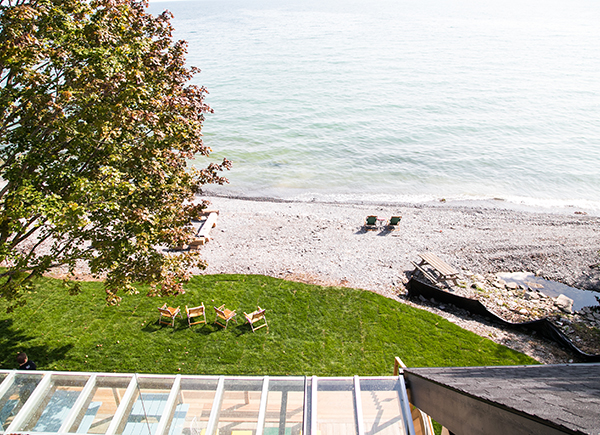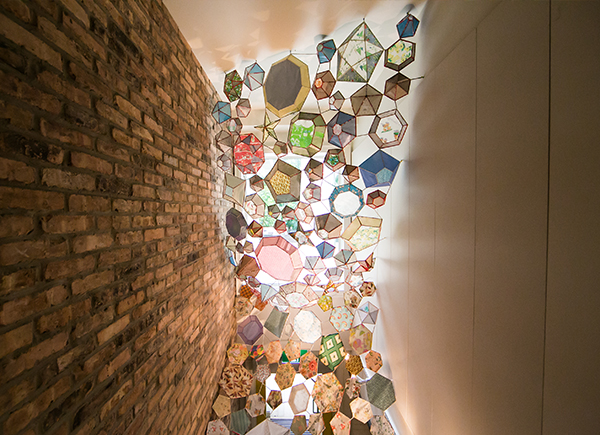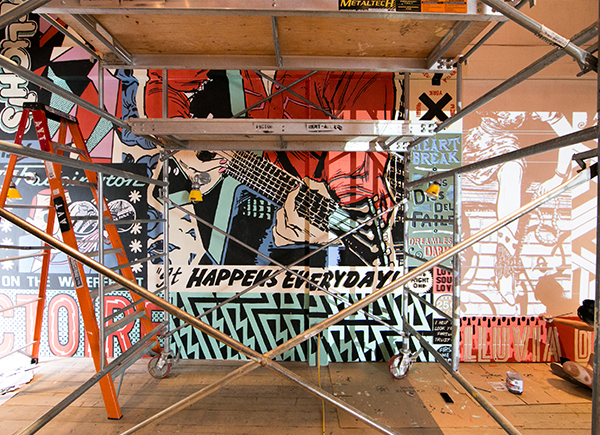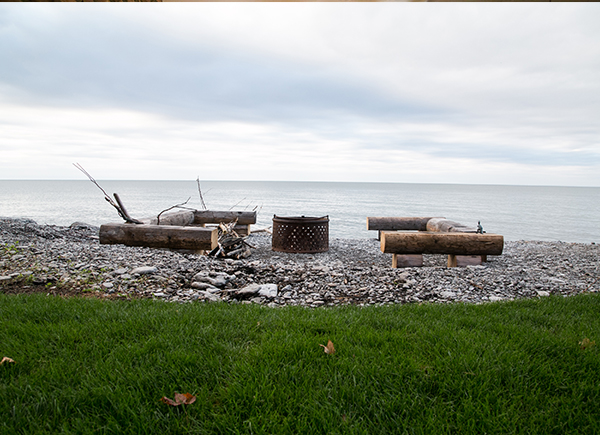In many ways, the Drake Hotel brand embodies the qualities we hold dear in the city of Toronto. The original Drake Hotel situated in the vibrant Queen West neighbourhood is the quintessentially Torontonian blend of old-world charm and urban modernity, with plenty of stunning artwork decorating its walls, and a multitude of live performances frequently held within its walls. It’s been a decade since the Drake opened, and it has since gained quite the reputation as much for its trendy design as for the cultural experience staying there offers.
Earlier this year, the Drake team opened a brand new boutique hotel seated by the lake in Prince Edward County called the Drake Devonshire.
While the inn technically opened its doors earlier this the fall, spring will be the hotel’s first official season. Now that warmer weather has finally arrived, sections of the hotel like its Pavilion (an indoor-outdoor pitched roof venue) will be up-and-running. Guests will also be able to enjoy the lush greenery and the stunning view from the patio.
The surrounding environments of the two Drake hotels couldn’t be more different—the original, set amongst the bright lights and bustle of the city, and the new hotel nestled by the lake, forests and sprawling vineyards—and yet, the design aesthetic remains consistent. John Tong of design firm +tongtong is the mastermind behind both the original Drake Hotel and the Drake Devonshire. Tong’s talent lies in his ability to design hotels that make the most of their unique surrounding environments while staying true to the Drake brand.
The Drake Devonshire is built upon the structure of an 1800s foundry, yet the interior design speaks to the modern aesthetic characteristic of the Drake. Tong cites the balance between old and new as a recurring theme in his work. Luxury and elegance are met with a quirky sense of humour, antique elements are tossed in with the contemporary and the rural environment is urbanized with modern design—these are the juxtapositions that Tong finds joy in crafting.
Read on for a peak into the design of the hotel and into the mind of Tong as he discusses his design inspiration and creative process.
Tell me about yourself. Why did you want to go into design?
I might not have thought of design the same way as a kid, but all I did was make stuff. I guess I was one of those kids that got toys and took them apart and made new toys with them…and that’s really what I do in life: I take things apart and make something new. I think that’s where it comes from. I think what would drive me crazy now is the Lego nowadays comes with prescribed end results—you buy this set and you make this car—when I was a kid you just got a box of Lego and were able to make all sorts of things. I guess you could do that now, but it’s really more geared towards an end product. This is what you want, this is what you get.
Would you ever consider designing toys yourself?
Oh yeah, definitely. I have done little things here and there. I’ve done things for the Design Exchange, like designing a toy car, and I’ve designed stuff for my kids. I have three kids and I’m always trying to get them to do their own thing. My parents were immigrants and I watched them sewing and creating as I grew up.
Can you tell me about your creative process when designing an interior?
When I worked on the first Drake Hotel in Toronto it was really a dialogue that I had with the owner and the client at the time, and our perspective on the boutique hotel. We felt strongly that when we travelled we really wanted to have a sense of where we were and that the places we stayed had some kind of authenticity in terms of location and culture. So yes, design is one thing, but how does the design reflect the community that it exists in and the environment around it? For the first Drake, for example, I did a study and portraiture of the Queen Street West neighbourhood (which was really different then from the way it is now), and tried to identify the community and engage and include the artistic community in that project. Likewise, with the Drake Devonshire, which is out in the rural setting (the very opposite of the urban setting we have here in Toronto), I kind of merge that with the client and the brand that is already established.
It there some sense of similarity between both hotels, given their very different environments? Is there something unique across all the interiors you design?
There are a lot of similarities and those similarities first come from trying to engage with the local culture and being inspired by it. I think from that point on it’s really about an attitude that is similar in both locations. That comes from the hotel and the brand and that has to do with this kind of whimsical cheekiness and bringing a sense of humour and irony. And then it’s really about curating and the balancing act for the Drake of bringing the old and new—the low-brow and luxury—craft and the high tech, modern and traditional together in a way that really had depth and has a hint of delight and surprise and all of those things. If you then look at our work specifically and our approach to designing most of our projects, what you’ll find is that we always try to find a different angle that hasn’t already been established. You know, trying to find a different way of using something that you’re less familiar with. The Drake has a very particular look in terms of bringing old and new together. There are parts that are completely contemporary, but even then we try to find some sense of humour and bring art and craft and design from a level that is really balanced.
I noticed that in the hotel interior there is beautiful artwork hanging on the walls. Mia Nielsen did a great job curating the display. When you were designing, did you have these pieces in mind? Did you create an environment for them, or were they added into your design?
Well, the original Drake began with very specific pieces that we had selected which acted spatially…but even then we were saying that we needed an art curator that would go out and engage with the artistic community so that the art is an evolving aspect of the experience. That program has really expanded and become one of the signature aspects of staying in a Drake hotel. So working with a curator, we knew that this layer was going to be a huge component for the project, so during the project we were aware of the things the curator was looking at. So some of the pieces are very spatial—they’re applied on the building; they’re wall murals. Other pieces are more traditional in that they’re in frames but the content and the subject matter always has a curious quirkiness. They’re odd, and it provokes people to have a different depth of experience in the space. Sometimes you don’t really know what the irony is until you’re there for a while, like: “Oh my god, there’s a Star Trek emblem on that…[Laughs].” We’re really interested in that extended experience where you understand things over time. So the art in some ways is a collection that is on display but some are really part of the space. This art will change over time, so the experience through art will change. The sense of evolution of the project is something that we built into the sense of the space.
I read that the interior design of the Drake Devonshire is a “nod to rustic Canadiana.” What does this term mean to you?
Canada really has an incredible landscape across the country and if you were European and you came to Canada they would say there was a distinct vernacular here that’s different from Europe. It’s something that I think is somehow deeply engrained in us; we may not acknowledge it and some of us might not even be aware of it. I’ve had a cottage up in the north near the Algonquin Parks and had the opportunity to be connected to the Canadian landscape. There is this sense of material difference of landscape that is somehow in our everyday lives, we just don’t really sense or acknowledge it. So “rustic Canadiana,” I think, is an acknowledgment that we are Canadian and we have a huge expanse of natural land and forest and there is a whole culture that is deep in our roots that we will draw out. So when we go out to Prince Edward County (a small town, with agriculture and vineyards), it’s the perfect place to really tap into this.
What makes Prince Edward County the new It spot for vacationing?
I think there is a desire in many people that are in urban centres, working very hard, like entrepreneurs and so on, that are not necessarily cottage people (and cottages are a lot of work), but that still want to go to a place where you have a sense of simpler times. They want to be on the water and in a community that is really flourishing in terms of its gastronomy and wine offerings. Prince Edward County is literally two-and-a-half hours outside of Toronto and it has incredible sandy beaches. So it is a really attractive escape for visitors around the city.
For more information and bookings, visit the Drake Devonshire’s website here.
Photography by Kayla Rocca.

